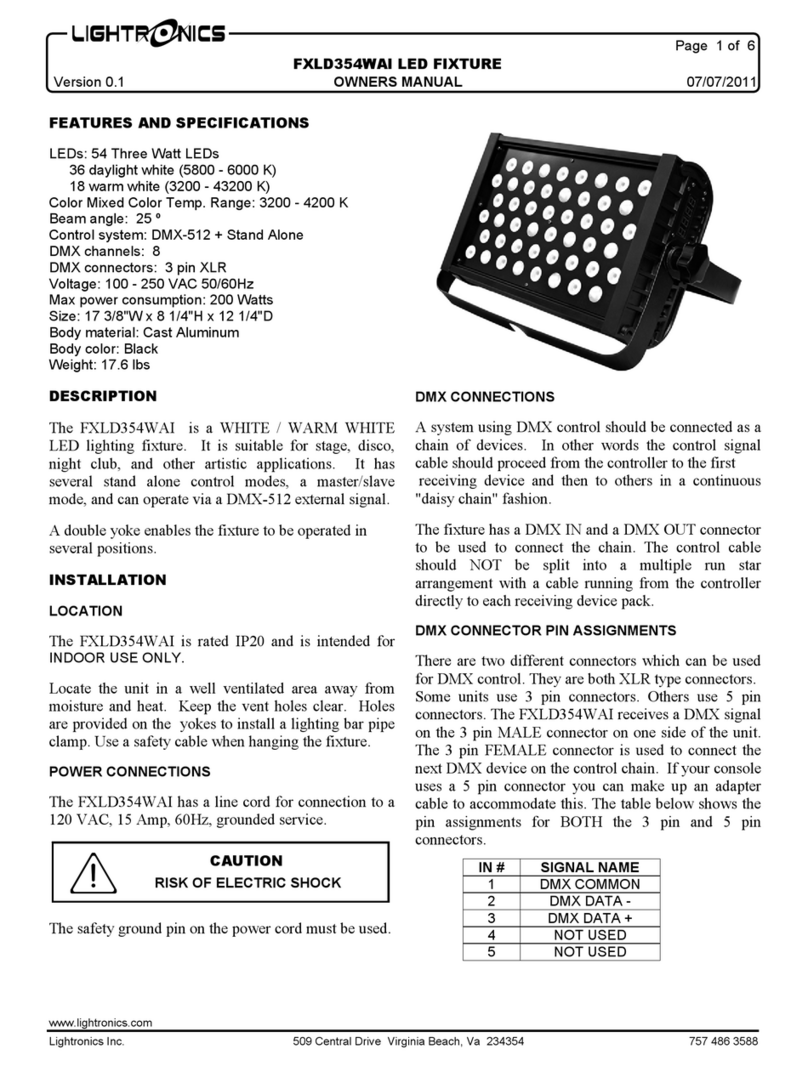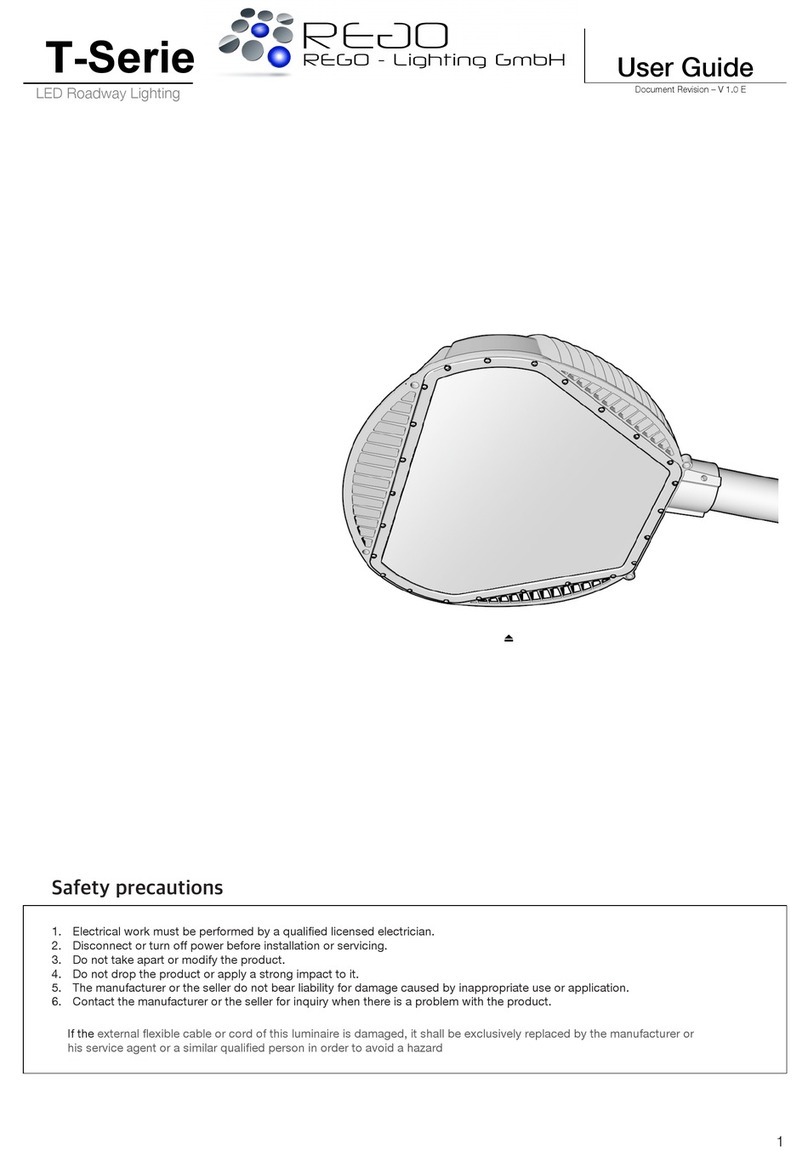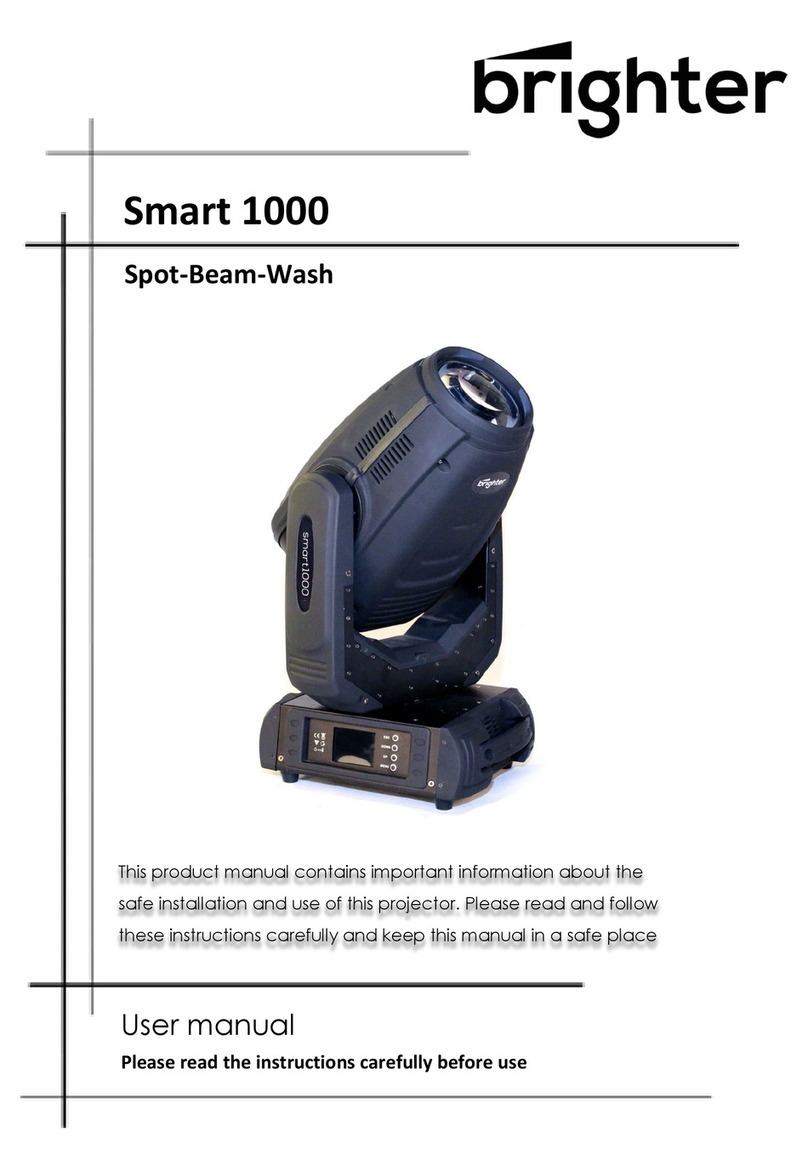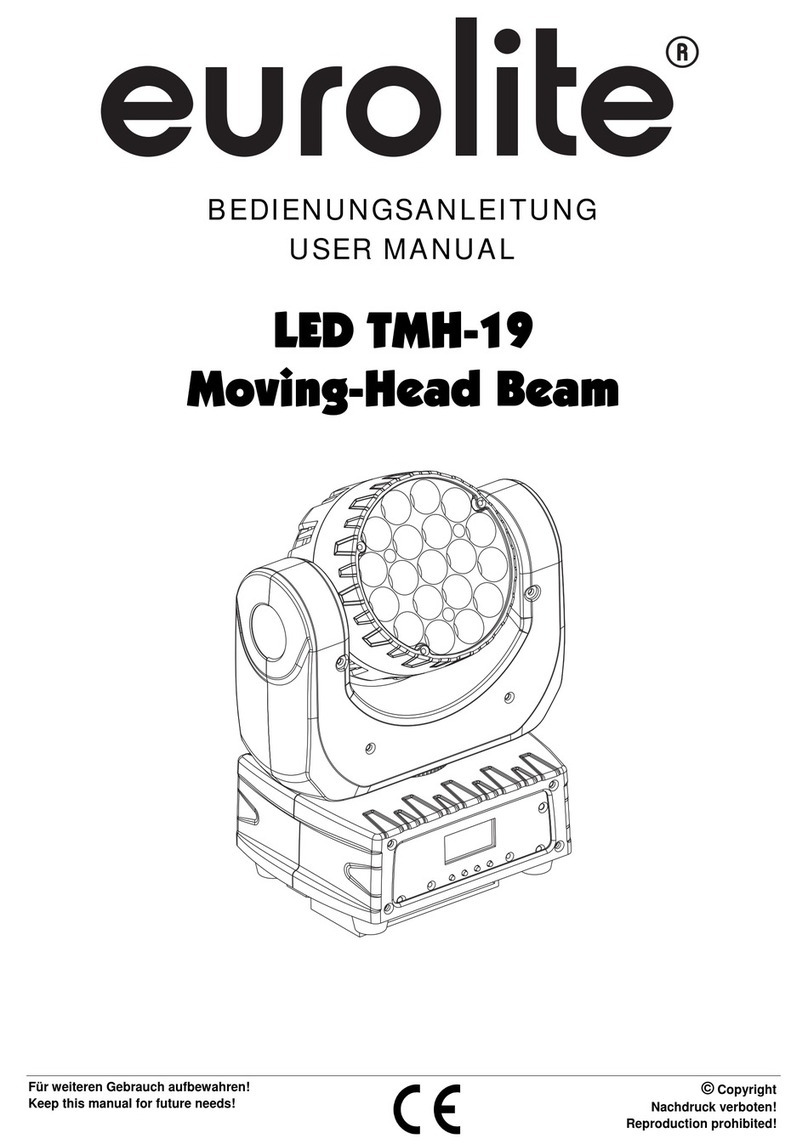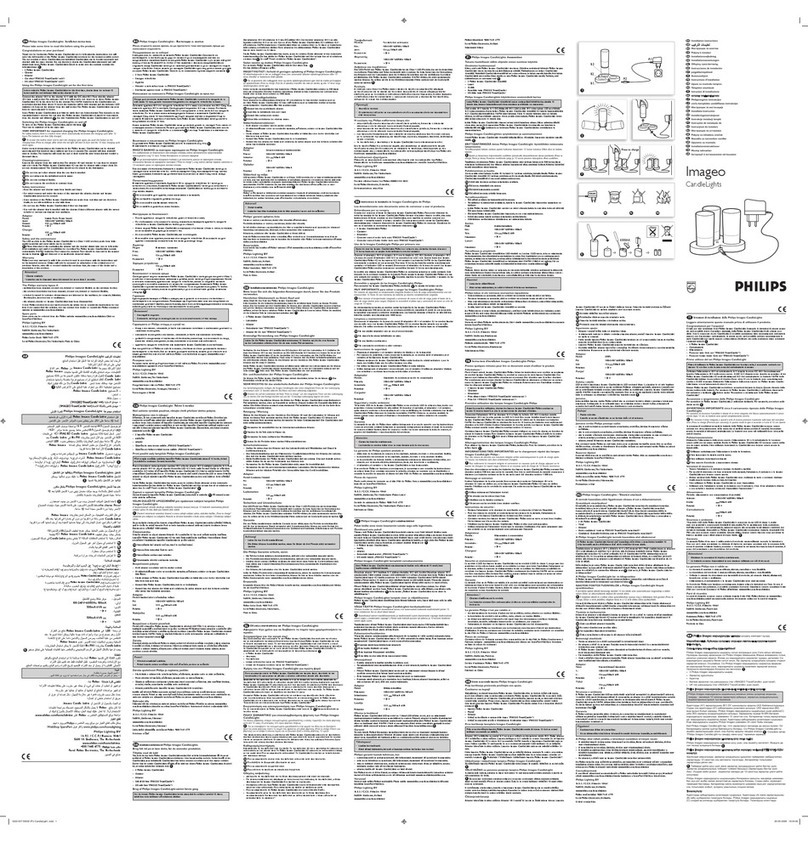Cineo Lightblade Edge Series User manual

Lightblade Edge
User Guide
Revision 1.0 — January, 2019
Information and specications in this document are subject to
change without notice.
www.cineolighting.com

2
NBCUniversal and Cineo have designed an
innovative, exible and modular professional
lighting tool: the Lightblade Edge. As a modular
xture, the Edge-series components can be
congured in a variety of combinations to t a
wide variety of applications. Combining the same
award-winning white light quality used in all
NBCUniversal / Cineo products with innovative
saturated color technology, Lightblade Edge
delivers up to 20,000 lumens of beautiful, easily
controllable, full-gamut light across a variety of
xture sizes. The Lightblade Edge delivers between
80 and 320 watts of power in both 2’and 4’ linear
models, and can be congured as single, double or
4-up light sources. Lightblade Edge is designed to
minimize weight, size and cost without sacricing
quality or creative control.
Lightblade Edge can be controlled via traditional
DMX/RDM, in either 8 or 16-bit resolution.
Operating modes include both Hue/Sat/Intensity/
CCT and Cineo’s “Smart RGB” mode, with individual
Red/Green/Blue/CCT controls that automatically
delivers optimum white light quality. Local user
control of individual Lightblades is accomplished
with an embedded control panel on each
Lightblade.
In addition to Cineo’s proprietary phosphor-
converted white light LEDs, we have developed
phosphor-converted saturated color LEDs. The
phosphor-converted LEDs use the exact same dies
as the white LEDs, ensuring that all light emitting
elements of the Lightblade Edge carry identical
thermal stability and perform over time with
identical dierential aging. After years of service,
Cineo’s color stability remains consistent.
All Lightblade Edge products are ruggedly
built, water resistant, and passively cooled for
completely silent operation. Each Lightblade
includes a detachable controller that can be
attached to the xture, or operate remotely up to
25 feet from the Lightblade.
Welcome to Lightblade Edge
Edge Series

3
General Notes
1. Please read through this manual carefully before operating Lightblade Edge, and keep this manual for
future reference.
2. There are numerous safety instructions and warnings that must be adhered to for your
own safety.
3. Lightblade Edge is not intended for residential use. It is intended for use in a professional studio.
4. Lightblade Edge must be serviced by a qualied technician.
5. The Lightblade Edge xtures are at rated as IP22 – for damp environments.
6. These products are not certied for use in hazardous locations.
7. Lightblade Edge xtures can operate at 40ºC (104ºF) above ambient temperature.
Fixture Set Up
Read these safety instructions carefully to ensure xture and accessories are used safely.
Ensure the mounting hardware is correctly connected to the xture before rigging.
Always use secondary safety cables of suitable length when hanging Lightblade Edge units.
The Lightblade Edge can weigh up to 16 lbs. (7.2 kg) excluding accessories. The combined weight should
be considered when choosing a suitable safety cable.
Safety cables must securely be attached to the Lightblade Edge and should be as short as possible to
reduce travel distance if primary hanging accessory fails.
Ensure that the mounting hardware is correctly tightened when manipulating Lightblade Edge in the
required orientation for safety purposes.
Ensure the Lightblade Edge is operated within an ambient temperature range of -20 to +40°C
(-4 to 104°F).

4
System Congurations
Lightblade Edge systems can be purchased in several congurations, based on the Lightblade lamphead
dimensions (2’ or 4’) and number of Lightblades in the xture (1, 2 or 4). The following chart describes the
details of each:
All Lightblade Edge congurations feature the following:
Completely icker-free operation
Silent, passive cooling: no fans
Environmental temperature range: -20ºC - +40º C
Max. temperature rise: +45º C
ETL, cETL, CE pending
Made in USA
Edge 80 Edge 160 Edge 320
2’ 4’ 2’ 4’ 2’ 4’
Size 24”W, 2.5”H,
2.5” D
48”W, 2.5”H,
2.5” D
24”W, 7” H, 3.4”
D
48”W, 7” H, 3.4”
D
24”W, 12.5”H,
4.7” D
48”W, 12.5”H,
4.7” D
610mm W,
64mm H,
64mm D
1.2m W, 64mm
H, 64mm D
610mm W,
178mm H,
87mm D
1.2m W, 178mm
H, 87mm D
610mm W,
317.5mm H,
120mm D
1.2m W,
317.5mm H,
120mm D
Weight 1.4 lb .6 kg 2.7 lb 1.2 kg 6.8 lb 3 kg 9.6 lb 4.4 kg 11.4 lb 5.1w kg 16 lb 7.3 kg
Mounting
3/8 - 16
Thread, Baby
Pin
3/8 - 16 Thread,
Baby Pin
3/8 - 16 Thread,
OmniMount
3/8 - 16 Thread,
OmniMount
3/8 - 16 Thread,
OmniMount
3/8 - 16 Thread,
OmniMount
Input Power 100 - 240 VAC 100 - 240 VAC 100 - 240 VAC 100 - 240 VAC 100 - 240 VAC 100 - 240 VAC
Power
Consumption 80W 80W 160W 160W 320W 320W
Output
(Lumens) 5,000 5,000 10,000 10,000 20,000 20,000
FC @ 10’ 22 22 45 45 90 90
Lux @ 3m 237 237 377 377 970 970
DMX
Interface RJ45 In/Thru RJ45 In/Thru 5-Pin XLR In/
Thru
5-Pin XLR In/
Thru
5-Pin XLR In/
Thru
5-Pin XLR In/
Thru

5
Color Space
The Lightblade Edge uses two separate LED engines to independently generate accurate white light,
variable from 2700K to 6500K, and an extended RGB gamut for broad saturated color space. The CIE 1931
diagram illustrates the Lightblade Edge color space.

6
System Components, Connections and Controls
Components
All Lightblade Edge congurations feature these characteristics:
The Lightblade Edge system essentially includes four dierent components that can be combined or
used individually to create optimized lighting xtures and systems. These are:
1. Lightblade Lampheads
Linear LED soft light sources, supporting ve LED channels: R, G, B, 2700K, 6500K. They are available in
both 24” (61 cm) and 48” (122 cm) lengths. Lightblade lampheads connect exclusively to Lightblade
Controllers via 10-wire RJ50 cables.
2. Lightblade Controllers
Lightblade Controllers are designed to provide both power and control to their attached Lightblade
lamphead. Each Lightblade Controller connects to a single Lightblade lamphead. Connections include
AC power and DMX/RDM. Local control is also provided. A secure 3/8-16 threaded mounting hole is
provided for attaching to standard grip equipment.
3. Power Chassis
The Lightblade Power Chassis is a convenient way to mount, power and control banks of Lightblades.
These come in two congurations: 2-Blade and 4-Blade. Power Chassis can accommodate both 2’ or 4’
Blades. The Power Chassis provides a power switch for the entire xture, AC distribution to all attached
Lightblades and a RJ45-to-5-pin XLR passive adapter for DMX. For convenience, the Power Chassis also
includes carrying handles and additional mounting options.
4. Additional mounting equipment
In addition to mounting a Lighblade xture with the included 5/8” baby pin, a QuikClik mounting clip
is available for mounting individual blades separate from the controller. The Power Chassis can be
mounted with the included baby pin, or can be used with a twist-on Omnimount plate.
Power Connections
The individual Lightblade Edge units are powered by a 110 – 240VAC power supply, internal to the
controller. Typical power connection is via the attached IEC pigtail. Alternatively, the controller can be
hard-wired using the power bus connectors, which are accessed by removing the safety power cover.
The Lightblade Edge xtures can be congured into multi-blade xtures using the Lightblade Power
Chassis, which are available in 2-Blade and 4-Blade congurations. These power chassis provide mounting
support, AC power distribution and switching, as well as convenient DMX connections in standard 5-pin
XLR connectors.
NOTES:
1. Ensure the power cable is disconnected before servicing.
2. Do not connect to a variable supply, such as a dimmer rack.
3. A self-resetting thermal breaker is located within the individual Lightblade controllers. The Power
Chassis also includes a fuse in the switch/IEC connector module.

7
Data Connections
All connectors for the Lightblades and their connected controllers are located on the ends of the units.
Note that the cable connecting the Lightblade and controller is RJ50 (10-wire). This diers from standard
RJ45 connectors (8 wire); these cables are NOT cross-compatible. DMX/RDM connectors use (2) RJ45
connectors, located on the opposite end of the controller. These are passive feed-through connectors
and are not load-terminated.
Wired DMX Connections
Depending on the conguration, Lightblade Edge use either RJ45 connectors or 5-Pin XLR male and
female connectors to receive and forward DMX and RDM signals. The RJ45 ports are loop-thru connectors
with no built-in termination, while the 5-pin XLR connectors on the Power Chassis is self-terminating and
does not require external DMX termination when used in a chain.
The RJ45 jacks conform to the industry-standard for DMX over CAT5/6 cable. It is not compatible for
network connections:
• Pin 1: Data +
• Pin 2: Data –
• Pin 7: Common
• Pin 8: Common
The 5-pin XLR wiring is as follows:
• Pin 1: Signal Common
• Pin 2: Data –
• Pin 3: Data +
• Pin 4: Spare
• Pin 5: Spare
Controls
The Lightblade Edge automatically selects LOCAL or DMX control modes, based on presence of valid
DMX signal. The control module, located on the back of each Lightblade Controller allows the user to
monitor (in DMX mode) or modify (in LOCAL mode) the operating parameters of the xture. It includes
(4) push-buttons and a 6-character display.
The Lightblade Controller displays and provides the controls to potentially change these six settings,
which subsequently alters the way the attached Lightblade operates. The display uses a single character
“Label” to show which parameter is being displayed and potentially adjusted, followed by the value.
All button presses are “rotating thru”so if the button is continually pressed it rotates thru all options or
values.

8
These six values are:
1. DMX Address – the starting address for the Lightblade. The rst character of the display shows “A”,
followed by values from 001 to 512.
2. DMX Personality – The display shows on of the four personality options: HSIC16, HSIC08, RGBC16,
RGBC08.
3. DMX Slot 1 –If the unit is in HSIC mode, the Label is “I”, followed by the intensity in values from 0-100%.
If RGBC mode the Label will be “R”, representing Red, with a value range of 0-100%
4. DMX Slot 2 - If HSIC mode this will be CCT. The Label character is “C”, with a value range is 2700-6500K.
If the unit is in RGBC mode this will be “G”, with a value range of 0-100%.
5. DMX Slot 3 – If HSIC mode this will be Saturation and labeled “S”. If RGBC mode this will be “B”. Value
range for either is 0-100%.
6. DMX Slot 4 – If HSIC mode this will be Hue, labeled “H”, with a value range of 0-360º. If RGBC mode this
will be CCT, labeled“C”, with a range of 2700-6500K.
If DMX is connected to the Lightblade Edge unit, the display will show the starting DMX address by
default. Values of each of the six settings can be viewed by cycling through the settings, although LOCAL
control is disabled. If no DMX is present, the unit displays LOCAL, and local control is enabled.
Local Control
The control module includes four color-coded buttons, with functions as follows:
MENU (Blue Button)– This selects one of the six settings being displayed and possibly modied. Each
press of this button rotates through these values that can be viewed and modied. The display remains
on the selected value for 20 sec. allowing the ability to monitor the DMX value live or modify using UP,
DOWN followed by ENTER. If no buttons are pressed for 20 sec. the display returns to the DMX Address
(for example“A 001”) or LOCAL, dependent on DMX signal presence.
UP (White Button)– increments the value displayed by 1 unit. If the button is held down more than 1 sec.
then this control auto-increments at higher speed allowing the user faster advance capability thru the
numbers.
DOWN (Black Button)– decrements the value displayed. If the button is held down more than 1 sec. then
this control auto-decrements at higher speed allowing the user faster decrementing capability thru the
numbers.
ENTER (Green Button)– this conrms the displayed of Address or Personality, changed by the UP and
DOWN buttons. If ENTER is not pressed within 20 sec of the last UP and/or DOWN change then the
display returns to DMX Address mode and NO changes are made.

9
Adjusting DMX starting Address
With LOCAL control enabled, when the display is showing the DMX Address, pressing the UP or DOWN
buttons changes the starting address for DMX. You must press the ENTER button within 20 seconds in
order to keep the new DMX address; otherwise it will revert to the previous address. The example to the
right shows the display for Address 001.
Adjusting the DMX Personality
With LOCAL control enabled, when the display is showing DMX Personality, for example“HSIC08”, it
reects the DMX Personality currently set. It can be modied using the UP and DOWN buttons followed
by ENTER. The 4 personality options are: HSIC16, HSIC08, RGBC16, RGBC08.
In HSIC personality, the following four DMX slots are (in sequence): Intensity, CCT, Saturation and Hue,
and can be operated in 8-bit or 16-bit DMX resolution.
In RGBC personality, the following four DMX slots are (in sequence): Red, Green, Blue and CCT. Select 8-bit
or 16-bit resolution.
You must press the ENTER button within 20 seconds in order to keep the new DMX address; otherwise it
will revert to the previous address.
Note that 16-bit resolution personalities are selected, the LOCAL controls also operate at the higher
resolution.
Adjusting DMX Slot 1
This shows the rst DMX slot value based on the current personality setting. The control console can
change the value of this channel using the UP/DOWN buttons, and results are reected on the output of
the xture. . No “ENTER”is required for the new value to take eect.
If the unit is in either 8-bit or 16-bit HSIC personalities, this slot adjusts Intensity, or overall output, 0-100%.
If the unit is in either RGBC personalities, this slot adjusts the value of the Red channel, 0-100%
Adjusting DMX Slot 2
This shows the second DMX slot value based on the current personality setting. The control console can
change the value of this channel using the UP/DOWN buttons, and results are reected on the output of
the xture. No “ENTER”is required for the new value to take eect.
If the unit is in either 8-bit or 16-bit HSIC personalities, this slot adjusts CCT, in values from 2700 to 6500K.
If the unit is in either RGBC personalities, this slot adjusts the value of the Green channel, 0-100%.

10
Adjusting DMX Slot 3
This shows the third DMX slot value based on the current personality setting. The control console can
change the value of this channel using the UP/DOWN buttons, and results are reected on the output of
the xture. No “ENTER”is required for the new value to take eect.
If the unit is in either 8-bit or 16-bit HSIC personalities, this slot adjusts amount of color Saturation, from
0-100%.
If the unit is in either RGBC personalities, this slot adjusts the value of the Blue channel, 0-100%.
Adjusting DMX Slot 4
This shows the fourth DMX slot value based on the current personality setting. The control console can
change the value of this channel using the UP/DOWN buttons, and results are reected on the output of
the xture. No “ENTER”is required for the new value to take eect.
If the unit is in either 8-bit or 16-bit HSIC personalities, this slot adjusts the Hue angle, from 0-360º.
If the unit is in either RGBC personalities, this slot adjusts the CCT, in values from 2700 to 6500K.
8-BIT vs 16-BIT
Standard DMX data structure is 8-bit, which limits the value range between 0-255. This is the preferable
operating mode for maximum compatibility with DMX controllers. If more precise control is required, the
unit can be operated in 16-bit mode, oering a value range of 0-65,535. On the surface, this sounds more
valuable than 8-bit mode, however operating in this mode assigns two DMX channels for each control,
working in pairs, requiring twice as many DMX addresses. The rst DMX channel in the pair is the COURSE
adjustment of the control, while the second channel is the FINE adjustment. The COURSE channels
operate identically to 8-bit controls, while the FINE channels in the pair adjust in-between adjacent
values of the COURSE control. To further explain, the COURSE channel adjusts values of 0-255 while the
FINE channel adjusts between only two control values. If, for example the COURSE channel is set at value
165, the FINE channel adjusts between 165 and 166. Fortunately, most professional lighting consoles
allow controls to be set up in 16-bit mode, so a single fader manages the two channels automatically. It is
recommended that 16-bit mode only be used when the DMX controller supports 16-bit operation.

11
HSIC vs RGBC
Both personalities oer advantages for specic applications, and are provided to meet the lighting
control space preferred by the individual user.
HSIC
In HSIC mode, the 4-channel DMX prole, as well as the local interface map as follows:
Intensity - Controls the total xture output. Cineo’s Photo-Accurate Dimming™ maps the 0-100%
dimming curve to actual camera stops for precise output control.
CCT - Adjusts the primary white light base from 2700-6500K.
Saturation - This control blends and balances the amount of saturated color with the CCT base, from
pristine white to deep artistic color.
Hue - To optionally add saturated color, the HUE control adjusts the RGB hue angle to be added with the
Saturation control.
RGBC
The RGB Personality is technically considered RGBC, where the reference white point can be selected
as well as values of the primary Red, Green and Blue channels. This is extremely valuable in correlating
RGB operation in context with the white balance selected on the camera. Cineo employs SmartRGB™
technology to provide color-accurate white when blending R, G and B signals. This allows RGBC users to
work within a prescribed CCT for the white point, with maximum color rendering.
RDM Support
The xture supports RDM Discovery and Identify commands for identifying xtures on the network.
The Lightblade Edge supports both GET and SET commands remotely through an RDM controller. The
GET information provided includes the Unit ID, device type, rmware revision, DMX address and DMX
Personality.
The unit supports SET Commands to allow remote programming of the following:
DMX Personality
DMX base address
Calibration (this should only be done by qualied service personal)

12
Settings
Photo-Accurate Dimming™
The dimming curve on the Lightblade Edge follows a strategy that provides relative output levels that
correspond to image capture. Both DMX values and local control levels directly correlate to camera stops
in a meaningful way. The result is extremely predictable light levels within the full output range of the
xture.
The following table shows the relationship between LOCAL values as they relate to camera stops:
DMX Value % Output increase Stop Increase
(0-100)
20% 100 0
40% 200 1
60% 400 2
80% 800 3
100% 1600 4
Here are examples of how to accurately match camera stops to dimming levels in Local Mode:
Local Dimming: The Rule of 20 (0-100 scale)
Increase output 1 Stop: Add 20 units (fc/lux is doubled)
Decrease output 1 Stop: Subtract 20 units (fc/lux is reduced 50%)
Adjust ½ Stop = 10 Units (0-100)
Adjust ¼ Stop = 5 Units (0-100)
When operating in DMX mode, each increase of 50 units (8-bit) doubles the light output, or the
equivalent of opening the lens 1 f-stop.
DMX Value % Output increase Stop Increase
(0-255)
50 100 0
100 200 1
150 400 2
200 800 3
250 1600 4

13
Here are examples of how to accurately match camera stops to dimming levels in DMX Mode:
DMX Dimming: The Rule of 50 (0-255 scale)
Increase output 1 Stop: Add 50 DMX values (fc/lux is doubled)
Decrease output 1 Stop: Subtract 50 DMX values (fc/lux is reduced 50%)
Adjust ½ Stop = 25 DMX Values
Adjust ¼ Stop = 12 DMX Values
DMX Values
The following table lists all the 8-bit DMX values for all of the xture presets:
Dimming CCT Saturation Color
100% 255 2700 000 0% 000 Red 000/255
-1 Stop 200 3200 034 10% 025 Yellow 043
-2 Stops 150 4300 107 20% 050 Green 085
-3 Stops 100 5600 195 50% 128 Cyan 127
-4 Stops 050 6500 255 80% 204 Blue 170
O 000 100% 255 Magenta 212
Note that changing the DMX values in sequential steps, as in performing a live dim to zero will add
a dimming hysteresis, or smoothing. When switching between DMX values of 5 or greater, the value
change is instantaneous, allowing the xture to be used for dynamic lighting eects, such as strobing.
Mounting Options
All Lightblade Edge congurations ship with a 3/8”threaded Baby Pin for basic xture mounting.
Optionally, the 160-Series and 320-Series can accommodate a twist-lock Kino mount. We also oer a
ush-mount Lightblade clip mount for mounting individual blades to walls, ceilings or set pieces. Be sure
to use safety cables whenever Lightblade Edge xtures are mounted.

14
Warnings, Disclaimers and Warranty
Risk of Electric shock / Risk of Fire
Do not open. To reduce the risk of electric shock, do not remove cover (or back). No user-
serviceable parts inside. Refer servicing to qualified service personnel.
Burning Injuries
Be aware of high temperatures in excess of 50°C inside the fixture during and after use. Do
not touch the LEDs to avoid burning injuries.
Flammable Materials
Keep flammable materials away from the installation. Insure that the amount of air flow
required for safe operation of the equipment is not compromised. Proper ventilation must be
provided.
ESD and LED’s
LED components used in the Lightblade Edge are ESD (Electro-Static Discharge) sensitive. To
prevent the possibility of destroying LED components do not touch either while in operation or
when switched off.
This Equipment MUST be Grounded
In order to protect against risk of electric shock, the installation should be properly grounded.
Defeating the purpose of the grounding type plug will expose you to the risk of electric shock.
AC Power Cords
Use only a rated IEC Connector. The user is responsible for ensuring power cables are of
adequate condition for each application. If the power cords are damaged, replace them only
with new ones.
Environmental: Disposal of Old Electrical & Electronic Equipment
This product shall not be treated as household waste.

15
CINEO LIGHTING LIMITED WARRANTY
Products from Cineo Lighting are warranted against defects in materials and workmanship
for two years from the date the Product is shipped to Customer. Products are guaranteed
to perform substantially in accordance with the accompanying written materials within the
warranty period under normal use.
If the Product fails to work as warranted, Cineo Lighting will, in its sole discretion, repair or
replace the Product with a new or remanufactured Product that is at least equivalent to the
original Product. Customer must obtain a Return Material Authorization number from Cineo
Lighting before returning any Products under warranty to Cineo Lighting.
Customer shall pay expenses for shipment of repaired or replacement Products to Cineo
Lighting’s repair facility. Any repaired or replaced Products will be warranted for the remainder
of the original warranty period or thirty (30) days, whichever is longer. Cineo Lighting will
pay shipping of repaired goods back to the customer. After examining and testing a returned
product, if Cineo Lighting concludes that a returned product is not defective, Customer will be
notified, the product returned at Customer’s expense.
This Limited Warranty is void if failure of the Products has resulted from accident, abuse,
misapplication, or use outside of normal operating conditions. Warranty is void if serial number
has been defaced or removed.
NO OTHER WARRANTIES. EXCEPT AS EXPRESSLY SET FORTH ABOVE, THE
PRODUCTS ARE PROVIDED “AS IS” WITHOUT WARRANTY OF ANY KIND, AND NO
OTHER WARRANTIES, EITHER EXPRESSED OR IMPLIED ARE MADE WITH RESPECT
TO THE PRODUCTS, INCLUDING BUT NOT LIMITED TO ANY IMPLIED WARRANTIES
OF MERCHANTABILITY, FITNESS FOR A PARTICULAR PURPOSE, TITLE OR NON-
INFRINGEMENT OR ANY OTHER WARRANTIES THAT MAY ARISE FROM USAGE OF
TRADE OR COURSE OF DEALING. ELEMENT DOES NOT WARRANT, GUARANTEE, OR
MAKE ANY REPRESENTATIONS REGARDING THE USE OF OR THE RESULTS OF THE
USE OF THE PRODUCTS IN TERMS OF CORRECTNESS, ACCURACY, RELIABILITY, OR
OTHERWISE AND DOES NOT WARRANT THAT THE OPERATION OF THE PRODUCTS WILL
BE UNINTERRUPTED OR ERROR FREE. CINEO LIGHTING EXPRESSLY DISCLAIMS ANY
WARRANTIES NOT STATED HEREIN. NO LIABILITY FOR CONSEQUENTIAL DAMAGES.
TO THE MAXIMUM EXTENT PERMITTED BY APPLICABLE LAW, IN NO EVENT SHALL
ELEMENT AND ITS LICENSORS, DISTRIBUTORS, AND SUPPLIERS (INCLUDING ITS
AND THEIR DIRECTORS, OFFICERS, EMPLOYEES, AND AGENTS) BE LIABLE FOR ANY
DAMAGES, INCLUDING, BUT NOT LIMITED TO, ANY SPECIAL, DIRECT, INDIRECT,
INCIDENTAL, EXEMPLARY, OR CONSEQUENTIAL DAMAGES, EXPENSES, LOST PROFITS,
INSTALLATION COSTS, LOST SAVINGS, BUSINESS INTERRUPTION, LOST BUSINESS
INFORMATION, OR ANY OTHER DAMAGES ARISING OUT OF THE USE OR INABILITY
TO USE THE PRODUCTS, EVEN IF ELEMENT OR ITS LICENSORS, DISTRIBUTORS, AND
SUPPLIERS HAS BEEN ADVISED OF THE POSSIBILITY OF SUCH DAMAGES. CINEO
LIGHTING’S TOTAL LIABILITY ON ALL CLAIMS, WHETHER IN CONTRACT, WARRANTY,
TORT (INCLUDING NEGLIGENCE OR BREACH OF STATUTORY DUTY), STRICT LIABILITY
OR OTHERWISE, SHALL NOT EXCEED THE AMOUNTS PAID BY CUSTOMER FOR THE
PRODUCTS.
Customer acknowledges that the applicable purchase price or license fee for the Products
reflects this allocation of risk. Because some states/jurisdictions do not allow the exclusion
or limitation of liability for consequential or incidental damages, the above limitation may not
apply. The above limitations shall apply notwithstanding the failure of any limited remedy to
fulfill its essential purpose.

www.cineolighting.com
Specifications are subject to change without
notice. Cineo Lighting are registered trademarks
of Cineo Lighting, Inc.
©2019 Cineo Lighting, Inc. v1.0 01-23 -19
Cineo Lighting
P.O. Box 808
El Granada, CA 94018
Silicon Valley | Los Angeles | New York
+1 310.425.3425
Edge Series
This manual suits for next models
3
Table of contents
Popular Light Fixture manuals by other brands

Light-Point
Light-Point Rorhat quick start guide

Westinghouse
Westinghouse Outdoor Lighting Fixture owner's manual
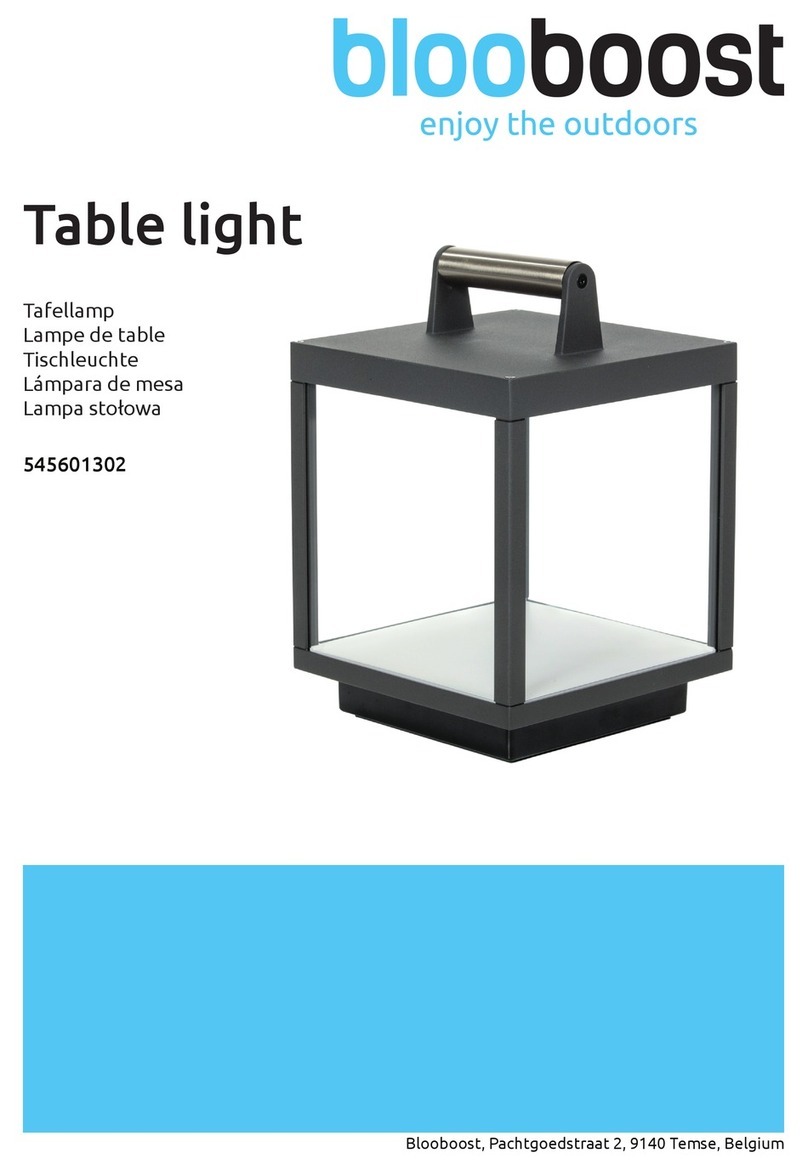
Blooboost
Blooboost 545601302 manual
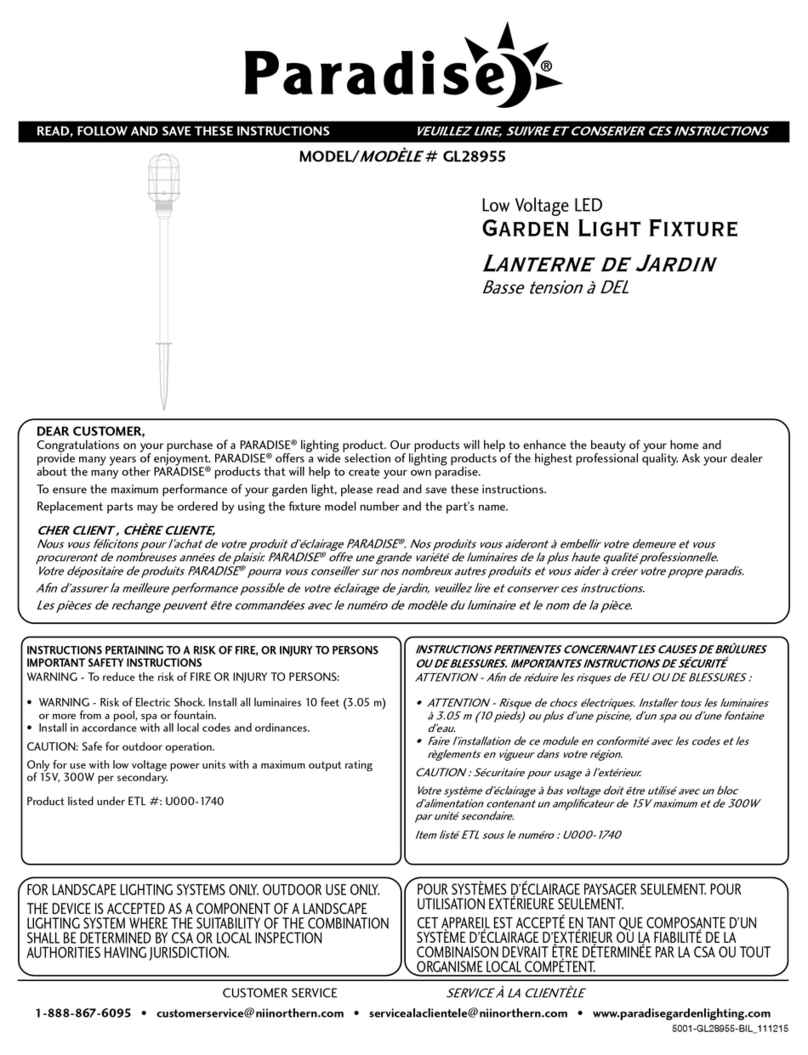
Paradise Datacom
Paradise Datacom GL28955 instructions
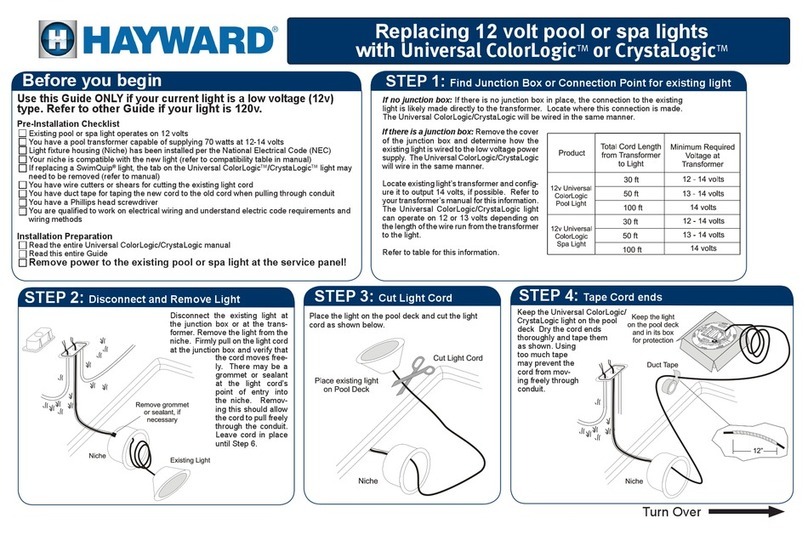
Hayward
Hayward Universal ColorLogic Replacement guide
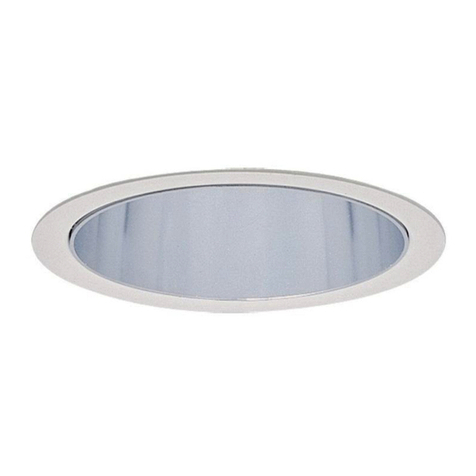
Lightolier
Lightolier Lytecaster 1071 specification



